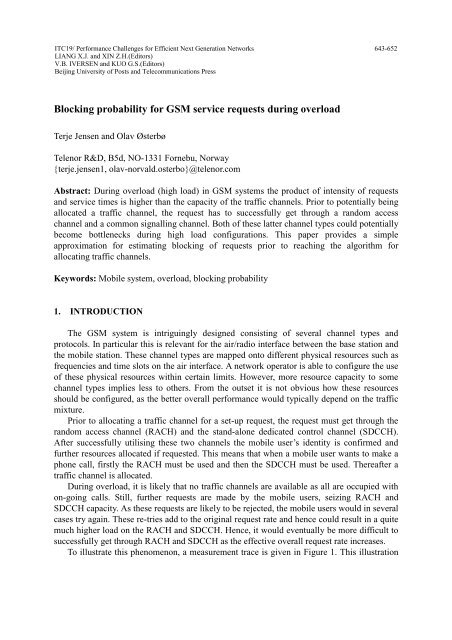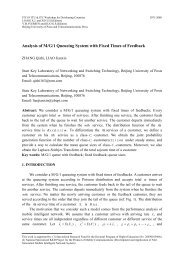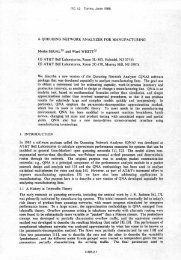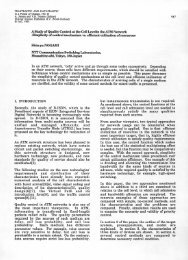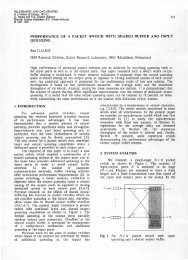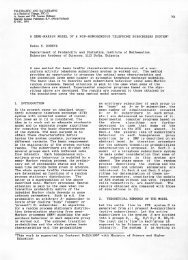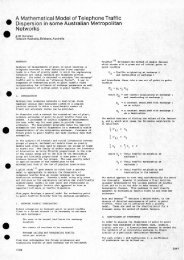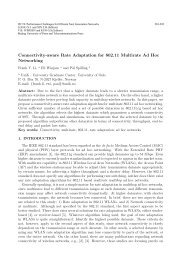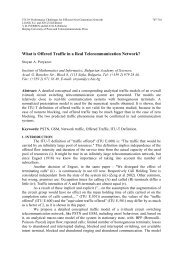Blocking probability for GSM service requests during overload
Blocking probability for GSM service requests during overload
Blocking probability for GSM service requests during overload
You also want an ePaper? Increase the reach of your titles
YUMPU automatically turns print PDFs into web optimized ePapers that Google loves.
ITC19/ Per<strong>for</strong>mance Challenges <strong>for</strong> Efficient Next Generation Networks<br />
LIANG X.J. and XIN Z.H.(Editors)<br />
V.B. IVERSEN and KUO G.S.(Editors)<br />
Beijing University of Posts and Telecommunications Press<br />
643-652<br />
<strong>Blocking</strong> <strong>probability</strong> <strong>for</strong> <strong>GSM</strong> <strong>service</strong> <strong>requests</strong> <strong>during</strong> <strong>overload</strong><br />
Terje Jensen and Olav Østerbø<br />
Telenor R&D, B5d, NO-1331 Fornebu, Norway<br />
{terje.jensen1, olav-norvald.osterbo}@telenor.com<br />
Abstract: During <strong>overload</strong> (high load) in <strong>GSM</strong> systems the product of intensity of <strong>requests</strong><br />
and <strong>service</strong> times is higher than the capacity of the traffic channels. Prior to potentially being<br />
allocated a traffic channel, the request has to successfully get through a random access<br />
channel and a common signalling channel. Both of these latter channel types could potentially<br />
become bottlenecks <strong>during</strong> high load configurations. This paper provides a simple<br />
approximation <strong>for</strong> estimating blocking of <strong>requests</strong> prior to reaching the algorithm <strong>for</strong><br />
allocating traffic channels.<br />
Keywords: Mobile system, <strong>overload</strong>, blocking <strong>probability</strong><br />
1. INTRODUCTION<br />
The <strong>GSM</strong> system is intriguingly designed consisting of several channel types and<br />
protocols. In particular this is relevant <strong>for</strong> the air/radio interface between the base station and<br />
the mobile station. These channel types are mapped onto different physical resources such as<br />
frequencies and time slots on the air interface. A network operator is able to configure the use<br />
of these physical resources within certain limits. However, more resource capacity to some<br />
channel types implies less to others. From the outset it is not obvious how these resources<br />
should be configured, as the better overall per<strong>for</strong>mance would typically depend on the traffic<br />
mixture.<br />
Prior to allocating a traffic channel <strong>for</strong> a set-up request, the request must get through the<br />
random access channel (RACH) and the stand-alone dedicated control channel (SDCCH).<br />
After successfully utilising these two channels the mobile user’s identity is confirmed and<br />
further resources allocated if requested. This means that when a mobile user wants to make a<br />
phone call, firstly the RACH must be used and then the SDCCH must be used. Thereafter a<br />
traffic channel is allocated.<br />
During <strong>overload</strong>, it is likely that no traffic channels are available as all are occupied with<br />
on-going calls. Still, further <strong>requests</strong> are made by the mobile users, seizing RACH and<br />
SDCCH capacity. As these <strong>requests</strong> are likely to be rejected, the mobile users would in several<br />
cases try again. These re-tries add to the original request rate and hence could result in a quite<br />
much higher load on the RACH and SDCCH. Hence, it would eventually be more difficult to<br />
successfully get through RACH and SDCCH as the effective overall request rate increases.<br />
To illustrate this phenomenon, a measurement trace is given in Figure 1. This illustration
644<br />
shows blocking on traffic channels (TCH) and SDCCH <strong>during</strong> an interval of a number of<br />
hours. The original cause of this situation was a chain collision close to the main airport in<br />
Norway. As seen, blocking rate of TCH was up to about 80% as average <strong>during</strong> a one-hour<br />
measurement. There were 13 traffic channels installed at that <strong>GSM</strong> site. <strong>Blocking</strong> and load on<br />
SDCCH are also indicated. An additional concern is that a user also needs access to an<br />
SDCCH in order to utilise the Short Message Service (SMS). In fact a high blocking ratio on<br />
SDCCH prevents access to all <strong>GSM</strong> <strong>service</strong>s.<br />
90<br />
80<br />
70<br />
SDCCH traffic (erlang)<br />
SDCCH meas cong (percent)<br />
TCH traffic (erlang)<br />
TCH meas cong (percent)<br />
60<br />
50<br />
40<br />
30<br />
20<br />
10<br />
0<br />
05:00 06:00 07:00 08:00 09:00 10:00 11:00 12:00 13:00<br />
Figure 1 Measured traffic and congestion on a certain <strong>GSM</strong> base station <strong>during</strong> high load<br />
situation<br />
This phenomenon of rejected <strong>requests</strong> and re-tries <strong>during</strong> high load situations is well<br />
known <strong>for</strong> different systems, including PSTN/ISDN and web servers. Depending on the<br />
“persistence” of the mobile users (i.e. how eager they are to re-try attempts), the fraction of<br />
successfully treated <strong>requests</strong> could become very low. For the configuration of RACH,<br />
SDCCH and TCH, different server models apply. For example, the RACH would have some<br />
similarities with slotted ALOHA systems. Results <strong>for</strong> such, and similar, configurations are<br />
available in a range of publications, a few being [1] and [2]. More detailed studies <strong>for</strong> wireless<br />
systems also considering propagation conditions have also been conducted, e.g. [3] and [4].<br />
Closer examinations of per<strong>for</strong>mance of RACH are also available, such as [5], [6] and [7].<br />
Compared to those publications, in this paper we are looking at both effects from SDCCH<br />
and RACH blocking. Hence, a main question addressed is: What is the <strong>probability</strong> of<br />
successfully getting through RACH and SDCCH in particular <strong>during</strong> high load intervals<br />
An objective of this paper is to elaborate a simple approximate method <strong>for</strong> estimating this<br />
blocking <strong>probability</strong>.<br />
A brief description of the system and the model is given in the following chapter. Then<br />
the analysis approach is presented in Chapter 3 supplemented with some results and<br />
observations in Chapter 4.
645<br />
2. SYSTEM AND MODEL DESCRIPTION<br />
A principle flow through different channel types used <strong>during</strong> a mobile user’s request is<br />
shown in Figure 2. Note that not all cases are shown, such as request collisions, retries,<br />
time-outs, etc. Moreover, a number of other channel types are not shown either, such as the<br />
one applied when acknowledging the random access request.<br />
sources<br />
Random<br />
access<br />
channel<br />
Stand-alone<br />
dedicated control<br />
channel<br />
voice<br />
Traffic<br />
channel<br />
SMS<br />
Figure 2 Principle flow of <strong>requests</strong> through different channel types as looked at in this<br />
model<br />
Considering a given <strong>overload</strong> situation, a working assumption here is that all traffic<br />
channels are occupied all the time. Naturally this is an approximation, although it is assumed<br />
that the overall load is so high that each request attempt has a very small <strong>probability</strong> of<br />
finding a traffic channel available. Referring to the situation shown in Figure 1 measured<br />
blocking on the traffic channels is about 70 – 80 % in average <strong>during</strong> two subsequent<br />
one-hour intervals. Hence, <strong>during</strong> several shorter intervals, all traffic channels were occupied.<br />
An effect of this working assumption is that the traffic channels do not need to be explicitly<br />
included in the model.<br />
A more detailed illustration of the model is given in Figure 3. A basic motivation <strong>for</strong> this<br />
model is to start with applying a number of simplifying assumptions allowing <strong>for</strong> fast<br />
assessment of per<strong>for</strong>mance estimates. In general the dependencies between inter-arrivals <strong>for</strong><br />
resource groups are neglected <strong>for</strong> this initial model. The traffic situations <strong>for</strong> the two resource<br />
groups are:<br />
• Random Access Channel (RACH): where mobile terminals are generating<br />
<strong>requests</strong> in defined slots – competing <strong>for</strong> these slots according to specified<br />
procedures. A maximum of n retries are applied when collisions occur (a<br />
modified slotted ALOHA-model). Holding time <strong>for</strong> this resource is a single slot<br />
when transfer is successful.<br />
• Stand-alone Dedicated Control Channel (SDCCH): allowing mobile terminals to<br />
signal its <strong>service</strong> <strong>requests</strong>. The mobile’s identity is also conveyed <strong>during</strong> this<br />
phase. Holding time <strong>for</strong> this resource has to be specified.
646<br />
Retries (decided<br />
by user)<br />
Mobile-originating<br />
Mobile-terminating<br />
Random access<br />
capacity<br />
Slow Dedicated<br />
Control Channel<br />
”unsuccessful”<br />
resource <strong>requests</strong><br />
”unsuccessful”<br />
resource <strong>requests</strong><br />
”new” attempts<br />
”effective” resource<br />
request attempts<br />
”successful” resource<br />
<strong>requests</strong><br />
Resource<br />
<strong>requests</strong><br />
”successful” resource<br />
<strong>requests</strong><br />
Figure 3 Model <strong>for</strong> per<strong>for</strong>mance analysis (upper: overall model, lower left: model <strong>for</strong><br />
“random access capacity”, lower right: model <strong>for</strong> “slow dedicated control channel”)<br />
3. ANALYSIS ALGORITHM<br />
3.1 Overall flow of calculations<br />
Neglecting the inter-arrival dependencies, the model allows <strong>for</strong> an iterative/sequential<br />
analysis, outlined as follows (illustrated in Figure 4):<br />
1. Given the “original” arrival rates <strong>for</strong> the <strong>requests</strong> – that is <strong>service</strong> initiation rates <strong>for</strong> “fresh<br />
calls“ as generated by the users.<br />
2. Estimate “effective” resource load on random access capacity considering the load and<br />
number of retries allowed.<br />
3. Calculate rate of “successful” <strong>requests</strong> <strong>for</strong> random access (continuing on to the SDCCH)<br />
and rate of “unsuccessful” <strong>requests</strong>.<br />
4. Calculate rate of “successful” <strong>requests</strong> <strong>for</strong> SDCCH and rate of “unsuccessful” <strong>requests</strong>.<br />
5. Calculate rate of retried call attempts (as controlled by the users)<br />
6. Check <strong>for</strong> convergence in main variables (e.g. arrival rates <strong>for</strong> resource groups) – end<br />
iteration when converged, continue from step 2 when not converged.<br />
.
647<br />
λ λ eff RACH λ⋅(1−b) SDCCH λ⋅(1−b)⋅(1-E)<br />
Figure 4 Overall flow of traffic in the modelled system<br />
3.2 Set of analysis <strong>for</strong>mulae<br />
The “original” arrival request rate is referred to by λ (ref. step 1 in calculation procedure).<br />
3.2.1 Random access capacity, RACH<br />
The RACH “effective” request rate can be calculated as (step 2 in the calculation<br />
procedure):<br />
n−1<br />
n<br />
n+<br />
1<br />
i<br />
n<br />
i 1−<br />
b<br />
λ<br />
eff<br />
= λ∑(<br />
i + 1) ⋅b<br />
⋅( 1−<br />
b)<br />
+ ( n + 1) ⋅λ<br />
⋅b<br />
= λ ⋅∑b<br />
= λ ⋅ , (1)<br />
1−<br />
b<br />
i=<br />
0<br />
where b indicates the <strong>probability</strong> that a request is colliding with a number of other <strong>requests</strong><br />
(and hence not successfully “served” by the random access capacity). This might be estimated<br />
by assuming a slotted ALOHA model <strong>for</strong> this capacity.<br />
Note that n refers to number of retries; hence in maximum (n +1) access attempts can be<br />
seen.<br />
For a population of M mobile stations, each having a given <strong>probability</strong> of initiating a<br />
“fresh” attempt in a random access time slot equal to r, the <strong>probability</strong> of a successful access,<br />
in case no retries were allowed, is found by:<br />
i=<br />
0<br />
M ⋅ r ⋅ (1 − r)<br />
M −1<br />
. Given that we are looking at a<br />
1<br />
particular mobile station, the <strong>probability</strong> becomes equal to<br />
(1 − r)<br />
M −<br />
. That is, an attempt is<br />
successful when none of the others are transmitting in the same slot. However, the retries add<br />
to the effective rate.<br />
The resulting <strong>probability</strong> that no other transmissions (“fresh” and retries) arrive in the<br />
same time slot as a given attempt is approximated by<br />
e − λ eff<br />
. This is introducing a Poissonian<br />
arrival model <strong>for</strong> <strong>requests</strong>. To some extent, this could be argued by a high number of mobile<br />
stations each having a certain request generating <strong>probability</strong> <strong>for</strong> that time slot. Hence, as a<br />
−λ<br />
eff<br />
first approximation: b =1 − e , (2)<br />
As shown, from these expressions, iteration can be applied solving:<br />
−λ<br />
n+<br />
{ 1−<br />
( 1−<br />
) }<br />
1<br />
eff<br />
e<br />
eff<br />
λ = M ⋅ r ⋅e<br />
. (3)<br />
eff<br />
λ<br />
Figure 5 shows relations between “fresh <strong>requests</strong>” and the effective rate of random access<br />
attempts <strong>for</strong> different values of n.
648<br />
λ eff n=7<br />
n=7<br />
0.4<br />
λ raeff<br />
n=1<br />
n=1<br />
λ eff 3.5<br />
n=7<br />
3<br />
0.5<br />
4<br />
0.3<br />
0.2<br />
0.1<br />
2.5<br />
2<br />
1.5<br />
1<br />
0.5<br />
n=1<br />
0.1 0.2 0.3 0.4 0.5<br />
M.r<br />
0.2 0.4 0.6 0.8 1<br />
M.r<br />
Figure 5 “Effective” request rate to RACH as function of the product M.r <strong>for</strong> some values<br />
of n. Left part shows more details <strong>for</strong> lower traffic areas<br />
1<br />
1<br />
− n+<br />
The <strong>probability</strong> that a given mobile station’s attempt gets through is then found as<br />
−λ<br />
eff<br />
b , where b = 1 − e . This function is depicted in Figure 6, note that the effective load<br />
on the access channel is the input variable. As a worst case, the effective load on the access<br />
channel is equal to (n +1) times the “fresh” attempts as seen from that resource/access channel<br />
(retries due to user impatience, user re-dials, etc. are not considered in this variable).<br />
Values <strong>for</strong> success <strong>probability</strong> as function of rate of “fresh <strong>requests</strong>” are given in Figure 7<br />
(ref. step 3 in procedure). As more retries are allowed the success <strong>probability</strong> has the steepest<br />
decrease as should be expected as the retries add to the overall load on the random access<br />
channel.<br />
1.2<br />
1.0<br />
0.8<br />
n=7<br />
0.6<br />
n=4<br />
n=3<br />
0.4<br />
n=1<br />
n=2<br />
0.2<br />
n=0<br />
0<br />
0 0.1 0.3 0.5 0.7 0.9 1.1 1.3 1.5 1.7 1.9<br />
Figure 6 Probability of successful attempt as function of effective load on access channel<br />
(i.e. including retries) <strong>for</strong> different number of maximal retry options.
649<br />
1<br />
0.8<br />
0.6<br />
0.4<br />
0.2<br />
0.2 0.4 0.6 0.8 1<br />
Figure 7 Probability of success as function of “fresh <strong>requests</strong>” – product M⋅r <strong>for</strong> different<br />
values of n = 0.7. n = 0 is the curve with the slowest decrease of success <strong>probability</strong> as function<br />
of increasing “fresh request” rate<br />
3.2.2 SDCCH capacity<br />
The per<strong>for</strong>mance of the SDCCHs under consideration will depend on the actual arrival<br />
process and the corresponding holding times. We assume that the losses due to lack of random<br />
access channels is negligible or that the actual thinning of the ordinary input stream due to<br />
random access loss is Poissonian. By this assumption, <strong>for</strong> step 4 in the procedure, we could<br />
analyse the SDCCHs by an M/G/s/s loss-system where s is the number of channels available.<br />
Consequently the loss <strong>probability</strong> due to lack of SDCCHs may be estimated by applying<br />
Erlang’s <strong>for</strong>mula. Further the “carried” rate offered to the ordinary speech channels may be<br />
estimated as:<br />
λ = λ 1−<br />
b){1<br />
− E ( λ(1<br />
− b)<br />
t )}<br />
(4)<br />
speach<br />
(<br />
1,<br />
s<br />
SDCCH<br />
where<br />
t<br />
SDCCH<br />
is the mean holding time of a dedicated control channel.<br />
3.2.3 Retries<br />
It is possible to extend the results above by considering the effect of retries (ref. step 5 in<br />
the calculation procedure). Assuming a fixed retry <strong>probability</strong>, p r , (independent of number of<br />
λ<br />
retries a user has been through), the resulting input rate has to be increased to ,<br />
1−<br />
however this can be adapted by just scaling the input rate due to retries. During heavy<br />
<strong>overload</strong> we believe that the increase of the input rate due to retries will be significant.<br />
p r
650<br />
4. EXAMPLES AND OBSERVATIONS<br />
The overall <strong>probability</strong> of success, given that this is modelled as a series of factors, is<br />
estimated by the product of the corresponding “blocking” probabilities. Again assuming<br />
independence, the average number of attempts needed is given by the inverse of the overall<br />
success <strong>probability</strong>. n = 4, that is, in total 5 attempts are assumed <strong>for</strong> all calculations in the<br />
following.<br />
If attempts are made every 5 second per mobile station, this can then be used <strong>for</strong><br />
estimating average time until a call gets through. Given 115 random access time slots per<br />
second, the effective load/rate <strong>for</strong> this resource group has to be scaled accordingly.<br />
Furthermore, assume 5 second “think time” between re-tries <strong>for</strong> a user facing an unsuccessful<br />
call attempt.<br />
1000 users/mobile stations will then generate a scaled load of (i.e. neglecting the<br />
relatively few calls that are connected): M⋅r = (1000/5sec)⋅(1sec/115) = 1.74.<br />
Similarly, a case of 300 users with the same behaviour results in M⋅r = 0.52. From Figure<br />
5 we find an effective rate (including “automatic retries” due to collisions) about 1.8. This<br />
gives <strong>probability</strong> of a successful request about 0.59. Hence, the arrival rate that the SDCCH<br />
resource group faces, in this case, is 0.59⋅(300/5s) = 35.4 per second. Assuming an SDDCH<br />
holding time of 5 seconds, gives an equivalent load of 177. This can be inserted into Erlang’s<br />
loss <strong>for</strong>mula giving blocking probabilities <strong>for</strong> the SDCCH resource group. The overall success<br />
<strong>probability</strong> is found by adding the success of the random access and the success (= 1 –<br />
blocking <strong>probability</strong>) <strong>for</strong> the SDCCH. In this calculation example, this success <strong>probability</strong><br />
would be rather small.<br />
In a similar manner, a number of graphs of the overall success <strong>probability</strong> are presented<br />
in the following. For all these calculations the number of mobile users, M, is assumed to be<br />
300. When 4 SDCCH channels are present, the random access channel is assumed to have 115<br />
slots per second. When higher numbers of SDCCH channels are used (8, 12, 16, 20 and 24)<br />
217 slots per second are given <strong>for</strong> the random access channel.<br />
Overall success probabilities given in the following are:<br />
- Figure 8 - left: function of time between repeated call attempts <strong>for</strong> mobile users (two<br />
illustrations – 24 SDCCH and 4 SDCCH). SDCCH holding time is 3 seconds.<br />
- Figure 8 - right: function of SDCCH holding time; 2 – 8 seconds. Time between call<br />
reattempts is 5 seconds (3 illustrations – 24 SDCCH, 8 SDCCH and 4 SDCCH).<br />
- Figure 9: function of number of SDCCH – 4, 8, 12, 16, 20 and 24. SDCCH holding<br />
time is assumed to be 3 seconds. Time between call reattempts is 5 seconds in left part,<br />
while that variable is 20 seconds in right part.<br />
During commercial operations one would commonly have a set of blocking requirements<br />
that should be met. However, <strong>overload</strong> situations would likely be exceptional allowing <strong>for</strong><br />
lower success probabilities. The results give indications on that even fairly small groups of<br />
mobile users, M = 300 in these cases, may lead to very low success ratios.
651<br />
0.5<br />
0.5<br />
0.4<br />
0.4<br />
0.3<br />
0.3<br />
0.2<br />
0.2<br />
0.1<br />
0.1<br />
- 2.5 5 7.5 10 12.5 15 17.5 20<br />
Figure 8 Overall success <strong>probability</strong>:<br />
3 4 5 6 7 8<br />
Left: as function of mobile station “think time”, i.e. time between repeated call<br />
attempts – “think time” from 0 to 20 seconds. 300 mobile users. Upper curve 24 SDCCH,<br />
lower curve 4 SDCCH. SDCCH holding time 3 second<br />
Right: function of SDCCH holding time (from 2 seconds till 8 seconds). Mobile “think<br />
time” is 5 seconds. 300 mobile users. Upper curve 24 SDCCH, intermediate curve 8<br />
SDCCH, lower curve 4 SDCCH.<br />
0.14<br />
0.12<br />
0.5<br />
0.1<br />
0.4<br />
0.08<br />
0.06<br />
0.04<br />
0.02<br />
0.3<br />
0.2<br />
0.1<br />
5 10 15 20 25<br />
5 10 15 20 25<br />
Figure 9 Overall success <strong>probability</strong><br />
Left: as function of number of SDCCH 4, 8, 12, 16, 20 and 24. Time between call<br />
reattempts (“think time”) is 5 seconds. SDCCH holding time 3 seconds.<br />
Right: as function of number of SDCCH 4, 8, 12, 16, 20 and 24. Time between call<br />
reattempts (“think time”) is 20 seconds. SDCCH holding time 3 seconds
652<br />
5. CONCLUDING REMARKS<br />
This paper describes a rough approximate model and analysis approach <strong>for</strong> estimating the<br />
<strong>probability</strong> that a request gets through the RACH and SDCCH <strong>during</strong> high load situations.<br />
Comparisons with simulations have been done <strong>for</strong> several of the results, showing that the<br />
accuracy well below 10 % deviation, although not included here. It also turned out that a<br />
cause <strong>for</strong> any discrepancy mainly stemmed from the SDCCH calculations. Hence, some<br />
modifications to the Markovian arrival process could looked into (e.g. applying Hayward’s<br />
approximation). However, this requires that more moments are know <strong>for</strong> the traffic flow after<br />
passing the RACH.<br />
Still, the rough modelling/analysing approach presented here allows <strong>for</strong> estimating the<br />
blocking probabilities of even reaching the state of requesting a traffic channel or transmitting<br />
an SMS.<br />
REFERENCES<br />
1. L. Kleinrock, S.S. Lam: Packet switching in a multiaccess Broadcast Channel:<br />
Per<strong>for</strong>mance Evaluation. IEEE Transaction on Communications. Vol. 23, Apr. 1975. p.<br />
410-422.<br />
2. C. Namislo: Analysis of Mobile Radio Slotted ALOHA Networks. IEEE Journal of<br />
Selected Areas in Communications. Vol.2 July 1984. p.583-588.<br />
3. C. van der Plas, J.P.M.G. Linnartz: Stability of Mobile Slotted ALOHA Network with<br />
Rayleigh Fading, Shadowing and Near-Far Effect. IEEE Transaction on Vehicular<br />
Technology. Vol. 39 Nov. 1990. p.359-366.<br />
4. A.U.H. Sheikh. Y.D. Yao, X. Wu: The ALOHA Systems in Shadowed Radio Channels with<br />
Slow or Fast Fading. IEEE Transactions on Vehicular Technology. Vol. 39, Nov. 1990.<br />
5. A. Eizenhofer , W.F. Detecon: Validation of the <strong>GSM</strong> Radio Interface Signalling Protocols<br />
– Selected Studies. IEEE Vehicular Technology Conference. May 1991. p.333-338.<br />
6. C. Luders, R. Haferbeck: The Per<strong>for</strong>mance of the <strong>GSM</strong> Random Access Procedure. IEEE<br />
Vehicular Technology Conference. June 1994. p.1165-1169.<br />
7. M.N. Islam, M.M. Mahfuz, M.R. Islam: Per<strong>for</strong>mance of Slotted ALOHA Based <strong>GSM</strong><br />
Access Network Considering the Impact of RACH Slots. IEEE Conference on Networks.<br />
Aug. 2002. p.298-301.


